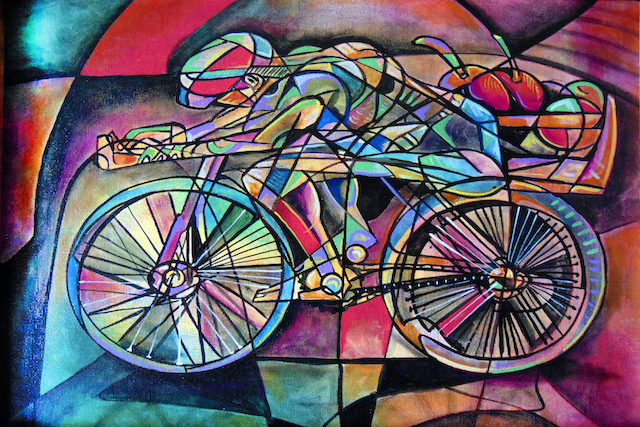
“I cannot make my days longer so I strive to make them better.” ~Henry David Thoreau
Every weekday morning, I set off from my back gate on my bicycle, pushing away from the safe shore of home and entering the unpredictable current of urban life. Every morning, I look forward to the adventure.
Over the course of the ride to work, I watch the city wake up. I feel the particular nuances of the day’s weather—perhaps humid, with a storm building over the mountains, or maybe a faintly warm breeze crosscuts the morning chill, carrying a hint of spring.
I know as I ride east that the rising sun is slightly higher than it was at this time last week. I smell coffee roasting and last night’s fried food dissipating as I pedal through the commercial district at the edge of the university campus. I see birds and runners and dog-walkers, and people doing yard work before the heat of the day sets in.
By the time I get to work, I’m ready to engage in my day. My bike ride serves as a transition from my habit of early morning solitude to a socially engaging workplace, where I need to be “on” most of the time.
Likewise, the ride home is a chance to release the day’s stress, to create a buffer between my work and personal lives.
Like many people, I struggle to keep work “in its place”: not to continue to obsess about it in my free time, to let it go until the next work day. Driving home so often contributes to stress. But when I arrive home by bike, it’s as if I’ve gradually released my work day with each circular swipe of my pedals.
There are many reasons to commute by bike. Simply put, it’s good for you and good for the planet.
But more subtly, and perhaps more importantly, bike commuting is a way to slow down the daily pace of life and to engage more fully with your mind, body, and community.
Bike commuting creates a time that is fully my own, a space in the day for meditation, re-connection, and release. I start and end the work day feeling present in the world and in myself, and in turn I am both more focused and more relaxed during those hours in between.
Most of all, riding a bike is personally empowering and mildly subversive. It is an act of courage in a world that is built for cars. And it is often considered mildly quirky in a culture that views bicycles as either toys or sports equipment, but not as a legitimate mode of transportation.
But to those of us who join, bicycling as a preferred form of transportation feels almost like a secret club, the key to a more balanced, healthy day and a way to live more lightly on our planet. It is a choice to spend time outside in the fresh air, using the power of our bodies to get around, rather than being trapped in traffic, locked away from the natural world and our fellow human beings.
This secret club is not an exclusive one, though—anyone can join! Here are a few tips to get started with bicycling:
1. Start small.
If you haven’t ridden a bike since you were a kid, start with a weekend ride around the neighborhood. Then run an errand by bike—somewhere within a couple of miles, along a familiar and safe route.
Gradually build up your comfort level, and if you feel ready to ride to work, do a practice run so that you know the safest route and how long it will take you to get there.
2. Get the right equipment.
Pulling your old bike out of the garage is a great place to start, but take it to your nearest bike shop for a tune-up before embarking on a long ride. Get a few basic tools—everything you need to change a flat tire, for example—and learn how to use them.
Bicycle advocacy groups in many communities offer classes on bike safety and maintenance. Ask about such a group at your local bike shop.
As you ride, you might realize you want a more comfortable bike or an easier setup for carrying things, such as bicycle panniers. There are many options, so the keys are comfort and convenience.
The old adage that “there’s no such thing as bad weather, only bad clothing,” holds true. If it’s hot, a change of clothes and some baby wipes can work wonders. Rain gear and fenders can combat a drizzle. Most importantly, if you don’t have a helmet, buy one and wear it.
If all this sounds like a big investment, start with the essentials. Keep in mind how much it costs you (and the environment) to drive your car.
3. Prioritize safety.
Take the time to figure out the safest route to your destination, which is likely not on major streets. I often find myself taking a less direct route to avoid vehicle traffic, and it’s always worth it. Not only is the ride safer, but it’s infinitely more pleasant to ride down a residential street than a major thoroughfare.
Cities have varying levels of bicycle infrastructure, but many have maps of bike routes as well as organizations that offer classes on how to ride safely. And this bears repeating: Wear a helmet!
4. Make riding as easy, or easier, than driving.
Keep your bike maintained, and invest in equipment that makes your ride safe and comfortable. Keep all tools and clothing in one space, perhaps a set of shelves near the door, so you won’t be searching for your hat and gloves while running late on a particularly cold morning.
If everything you need is right at your fingertips, there will be fewer excuses not to ride.
5. Change your attitude.
Instead of thinking, “I would ride, but it would be so much easier/faster/less sweaty to drive,” focus on how good you will feel if you do ride. Plan it into your day, giving yourself enough time to ride, change clothes, and cool off before a meeting, for example.
6. Remember: It doesn’t have to be all or nothing.
Make a goal to ride to work once a week, or if that’s too far, to run easy errands by bike. Add more days as you feel ready, or plan to ride on days when it’s most convenient, for whatever reason. Practice discipline and self-forgiveness: Ride when you can, and keep it fun.
The more you ride, the more fun it will be, and… the more you’ll ride.
About Tory Syracuse
Tory Syracuse works, writes and plays in Tucson, Arizona. You can read more of her work at http://tucsonporchswing.blogspot.com.












 Though I run this site, it is not mine. It's ours. It's not about me. It's about us. Your stories and your wisdom are just as meaningful as mine.
Though I run this site, it is not mine. It's ours. It's not about me. It's about us. Your stories and your wisdom are just as meaningful as mine. 